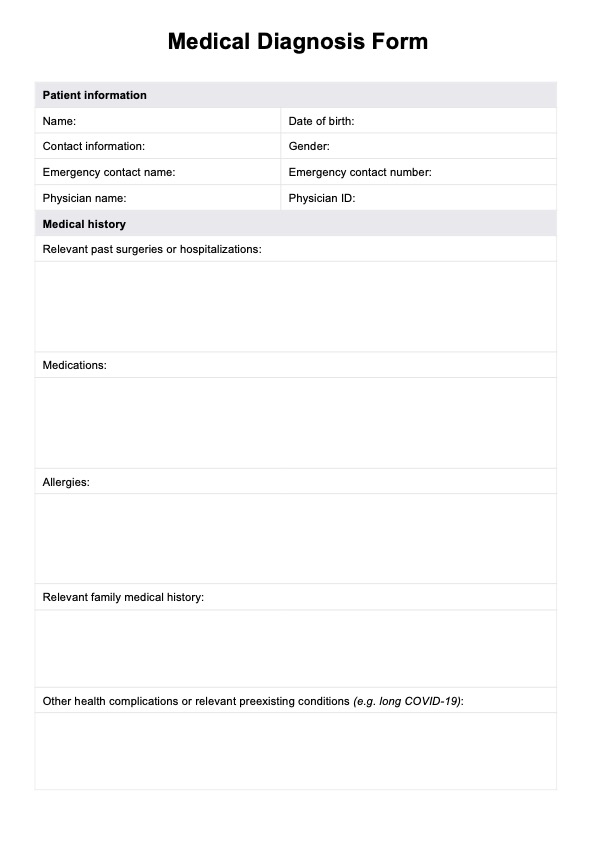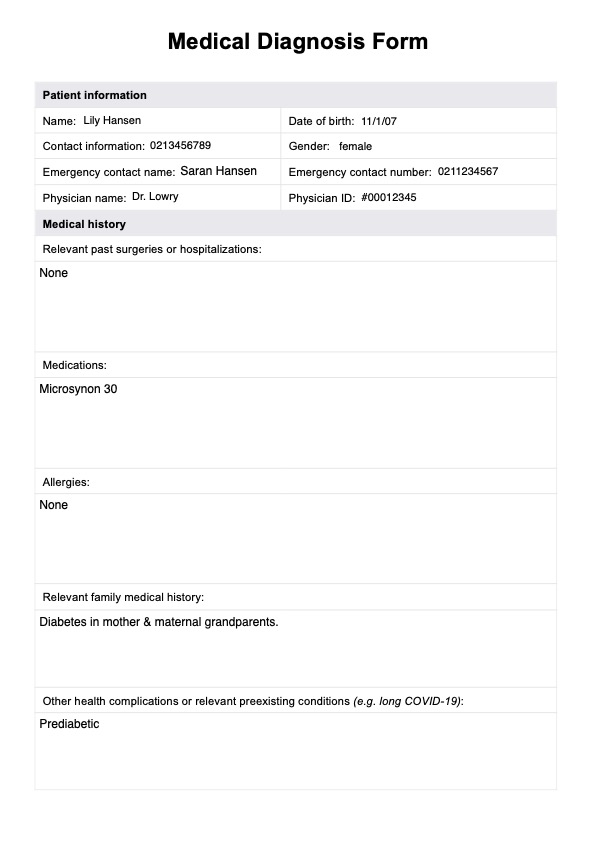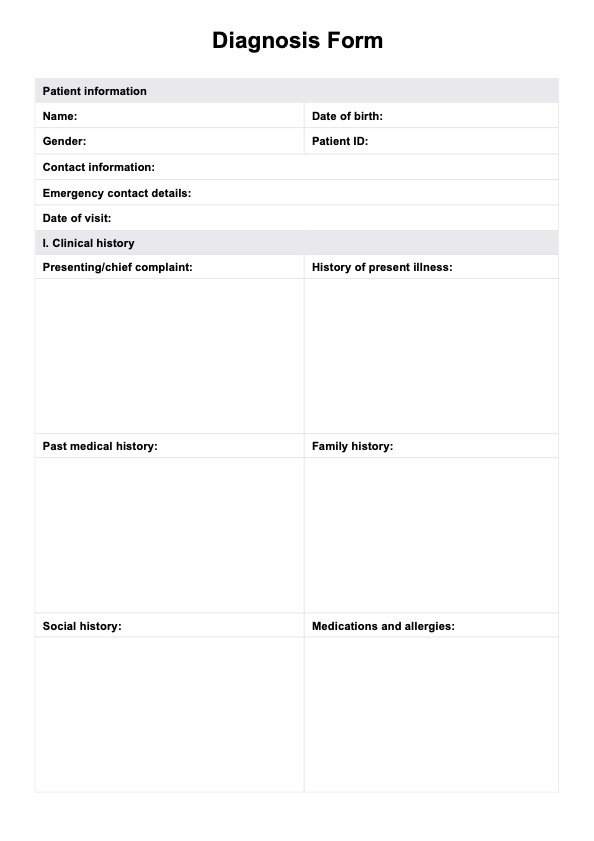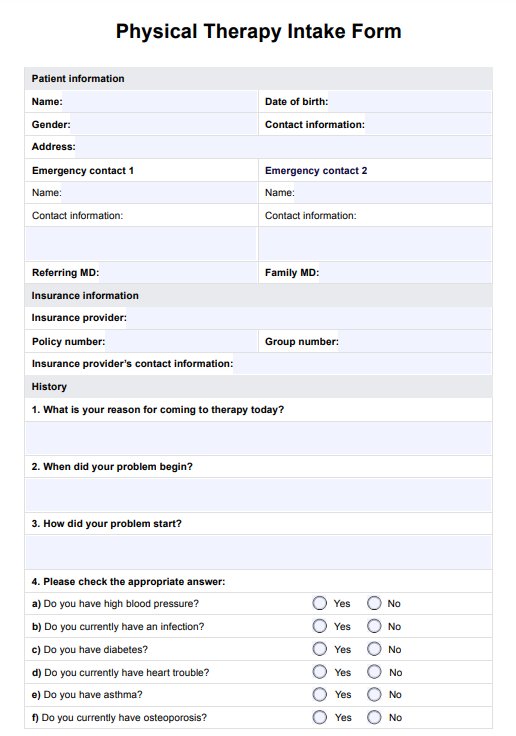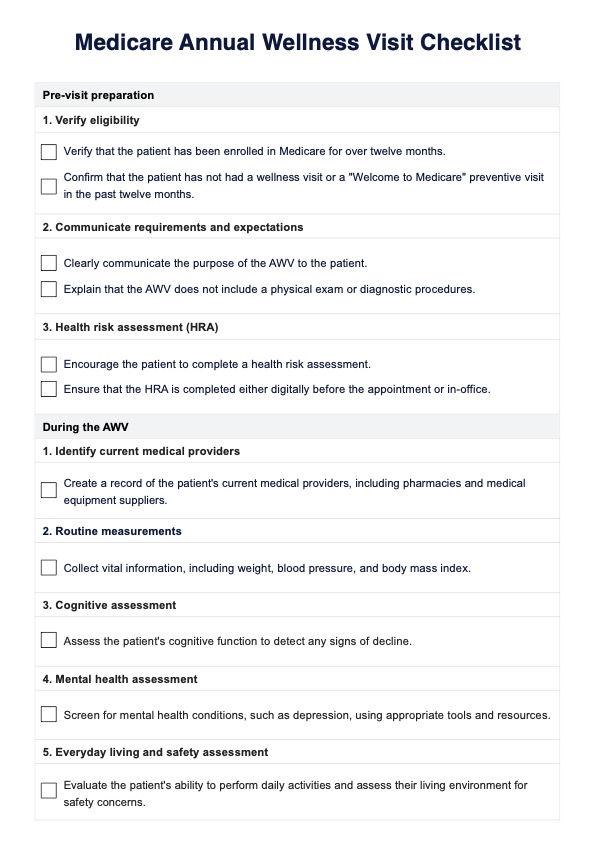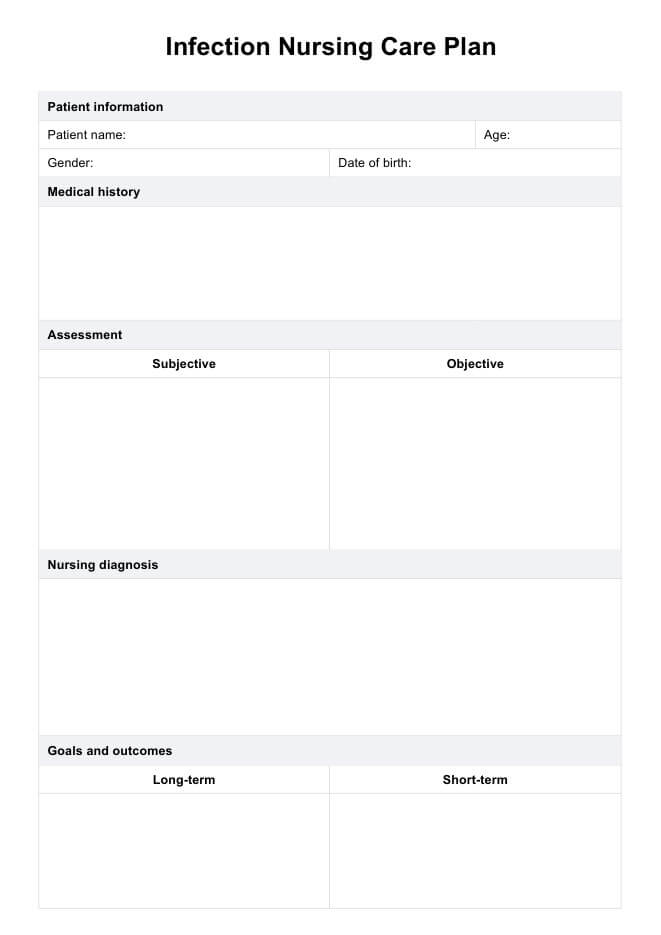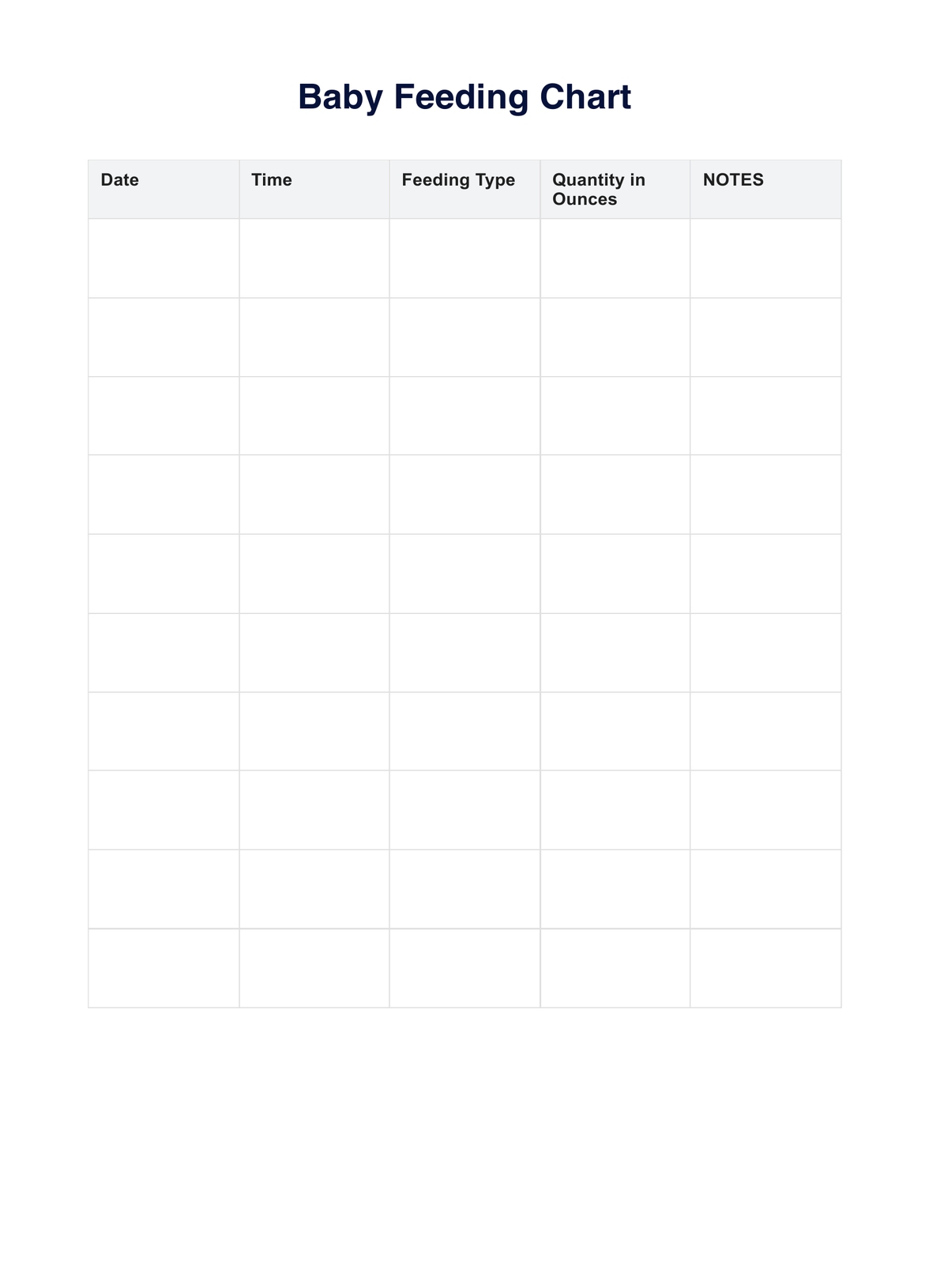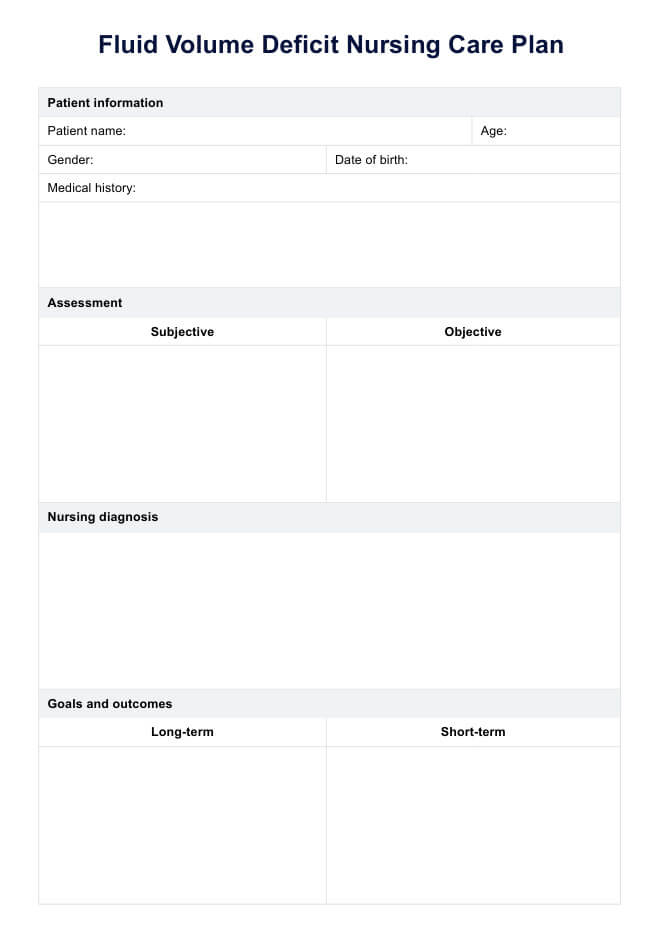Medical Diagnosis Form
Access a Medical Diagnosis Form template for healthcare professionals and comprehensively gather patient information for accurate diagnosis documentation.


What is a Medical Diagnosis Form?
Proper documentation is essential to quality healthcare. Correct and accurate record keeping facilitates continuity of care and ensures legal and regulatory compliance. A Medical Diagnosis Form template is one resource that assists healthcare practitioners in accurately recording the diagnostic process.
The form typically collects details about a patient's medical history, current symptoms, medications, diagnostic test results, and allergies. This information helps to paint a comprehensive picture of a patient's health. The form's structured format ensures that all essential details are documented systematically.
This facilitates clear communication between the patient and the doctor and between healthcare professionals. The doctor's diagnosis form is a valuable aid for healthcare professionals to analyze all relevant aspects of a patient's condition and make an informed decision about the most appropriate diagnosis.
Medical Diagnosis Form Template
Medical Diagnosis Form Example
What is included in a Medical Diagnosis Form?
A Medical Diagnosis Form gathers a comprehensive picture of a patient's health. Here's a breakdown of what this template includes:
- Patient information: Patient's name, date of birth, contact information, and emergency contact details.
- Medical history: Past surgeries, illnesses, current medications and dosages, allergies, family medical history.
- Presenting complaint: the symptoms that prompted the visit, including their duration, frequency, and severity.
- Review of systems (ROS): Inquiry into patient's health across body systems (e.g. respiratory, digestive, cardiovascular, or neurological).
- Physical Examination findings: Observations from the exam, pain localization, vital signs (blood pressure, temperature), and physical abnormalities.
- Diagnostic tests: Results from any ordered tests like blood tests, imaging studies (X-rays, MRIs), and specialized exams.
- Assessment and recommendation: the practitioner's assessment, diagnosis,and recommendations for further management (medications, procedures, specialist referrals).
What is included in a Medical Diagnosis Form?
A Medical Diagnosis Form consists of several sections to gather a comprehensive picture of a patient's health. Here's a breakdown of what you might find:
- Patient information: Patient's name, date of birth, contact info, emergency contact details.
- Medical history: Past surgeries, illnesses, current meds and dosages, allergies, family medical history.
- Presenting complaint: Symptoms prompting visit, their duration, and severity.
- Review of systems (ROS): Inquiry into patient's health across body systems - respiratory, digestive, cardiovascular, neurological, etc.
- Physical Examination findings: Observations from the exam, vital signs (blood pressure, temperature), physical abnormalities.
- Diagnostic tests: Ordered tests like blood tests, imaging studies (X-rays, MRIs), specialized exams.
- Assessment and plan: Practitioner's assessment, diagnosis, treatment plan, recommendations for further management (medications, procedures, specialist referrals).
How to use this Medical Form Diagnosis template?
The Medical Diagnosis Form is designed to ensure all essential data collected during the diagnostic process is recorded accurately. It can also be helpful as a tool to assist practitioners during physical assessments. Here's how it works:
Step 1: Access the template
Click "Use template" to open the Medical Diagnosis Form template on the Carepatron app. You can customize the template before saving it to your computer or device for easy access. You can also click "Download" to get a non-customizable PDF version.
Step 2: Gather patient information
Fill in the patient information section with the relevant details. Ensure the patient's name, date of birth, contact information, assessment date and medical history are all recorded accurately.
Step 3: Document presenting complaint and review of systems
Describe the patient's symptoms and duration in the presenting complaint section.
Step 4: Complete the diagnosis sections
Record any physical examination findings made by the doctor. Specify any diagnostic tests ordered, such as X-rays or blood tests, as well as their results. Provide an evaluation of the patient's condition, including their diagnosis and proposed treatment plan.
Other medical professionals should be able to clearly see how the physician reached the diagnosis based on the information provided on the Medical Diagnosis Form.
Benefits of using a Medical Diagnosis Form
Accurately documenting the diagnosis lays the foundation for effective treatment. Here are some of the key benefits of using a Medical Diagnosis Form template:
Facilitating accurate documentation
The form ensures all vital patient information is captured systematically, promoting clear communication between doctors and patients and allowing for better continuity of care across providers.
Accurate diagnosis
The form serves as a reference point for symptoms and medical history, enabling healthcare professionals to make a precise and timely diagnosis. It also helps identify any underlying conditions, contributing factors, and significant symptoms that may impact treatment options.
Improved patient understanding
Using a Medical Diagnosis Form can also improve the patient's comprehension of their condition and treatment plan. It allows patients to better engage with their diagnosis and treatment, and provides them a systematized diagnosis summary which is crucial for administrative purposes (e.g. insurance).
Improved communication
This template is designed to gather all the crucial information that led to a patient's diagnosis in a comprehensive summary. This helps other healthcare providers understand the diagnosis and is especially crucial if another physician contests the diagnosis or if the patient seeks a second opinion. Using this diagnosis template promotes clear communication and transparency.
Commonly asked questions
A Medical Diagnosis Form (or doctor diagnosis form) is a basic document that details a patient's diagnosis and all the relevant details such as lab results, physical assessment observations, and symptoms. The medical diagnosis template ensures all the key details are captured.
To complete the Medical Diagnosis Form digitally, save the file to your computer, upload it to your healthcare provider's online patient portal, and complete the form electronically.
To create a custom Medical Diagnosis Form on Carepatron, navigate to the platform's settings, select the form builder tool, and personalize the form according to your specific requirements and preferences.
Specific guidelines for filling out the medical diagnosis form include providing accurate and complete information, adhering to HIPAA regulations for patient privacy and data security, and seeking professional guidance if unsure about any form.


